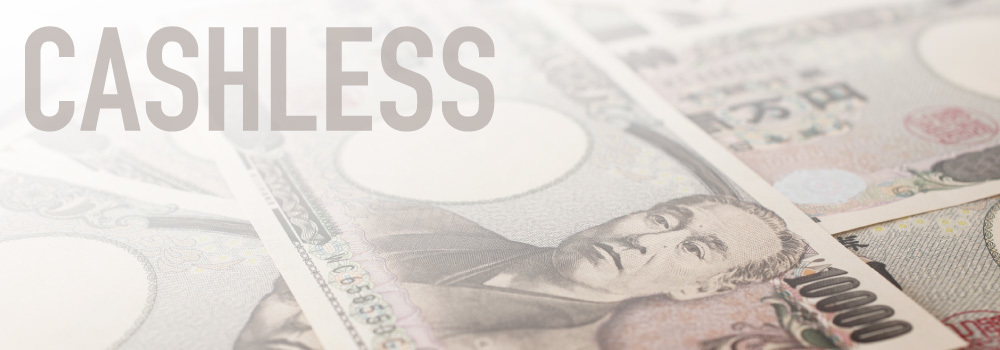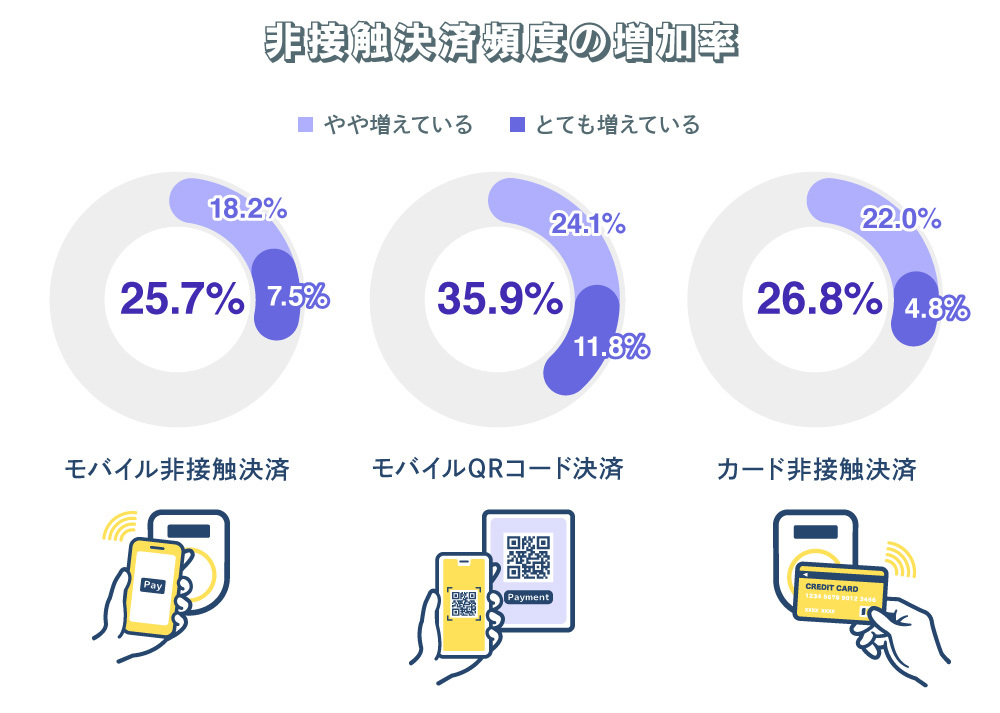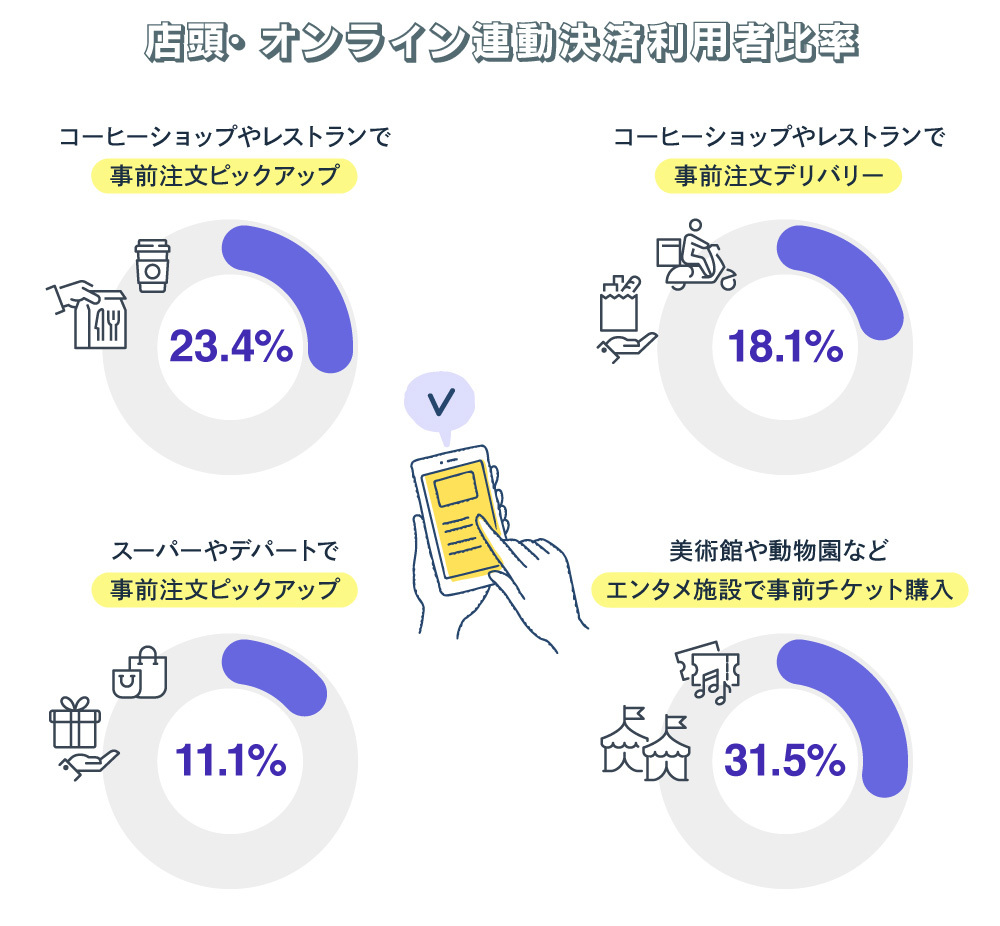Dentsu Inc. conducted its second "Cashless Awareness Survey" ( survey overview here ). The purpose of this survey is to clarify how consumers' payment methods are changing amid significant lifestyle shifts due to the novel coronavirus, and what payment methods will become mainstream going forward. This series will use the survey results to unravel the current state of growth in cashless users in Japan and the barriers that still hinder its advancement.
This installment explores the potential for contactless payment adoption in Japan.

Japan's Contactless Payment Usage Lags Behind the World

Source: Dentsu Inc. Cashless Project "Survey on Cashless Awareness Among Consumers During the COVID-19 Pandemic, December 2021"
[Sample size: 500].
Contactless payments are considered the most hygienically safe payment method. The reason is that there is no physical exchange of cash or contact with the other person's hands, unlike when paying with cash.
Most magnetic stripe cards must be handed to the cashier to be swiped. PIN-based IC cards require inserting the card into a terminal touched by many people and entering a PIN code. Both involve the risk of touching human hands or payment terminals.
In contrast, contactless payments are safe because, as the name implies, they involve no contact with people or terminals. There are three types of contactless payment tools: mobile contactless payments (NFC type*), mobile QR code payments, and card contactless payments.
※ = Mobile contactless payment (NFC type)
A payment method where a smartphone equipped with a contactless IC chip is held near a payment terminal. "NFC" stands for "Near Field Communication," referring to short-range wireless communication.
We asked which contactless payment method users felt they had used more frequently in the past three months. The highest percentage of respondents answering "significantly increased" was for mobile QR code payments (11.8%). This response rate was higher than for NFC-type mobile contactless payments (7.5%) and card contactless payments (4.8%). Even when including "slightly increased," mobile QR code payments still topped the list at 35.9%. However, while the world rapidly shifted toward contactless payments during the COVID-19 pandemic, looking at other countries suggests Japan remains at a relatively low level.
For example, in the UK, the proportion of contactless payments within total card transactions is increasing. In September 2021 alone, 69% of debit card transactions and 53% of credit card transactions were contactless. This represents a 30.5% increase compared to the same month the previous year and a 70.3% increase compared to the same month in 2019. In terms of value, it reached £15 billion (approximately ¥2.25 trillion), a 30.1% increase year-on-year and a remarkable 114.6% increase compared to the same period in 2019. (Source: Barclaycard survey)
The Limit of How Long Japanese People Can Tolerate Waiting in Line at Checkout ~ The Key to Eliminating Checkout Queues Lies in Contactless Payments

Source: Dentsu Inc. Cashless Project "Survey on Cashless Awareness Among Consumers During the COVID-19 Pandemic, December 2021"
[Sample Size: 500]
Paying cashless at the register speeds up checkout. One major retail chain reportedly saw processing speeds increase by 1.5 times after introducing cashless lanes. So, how much patience do Japanese consumers have for checkout lines, especially when contactless payments haven't fully caught on yet?
This survey asked respondents how many people in line at supermarket or convenience store registers would make them leave.
The most common response was "I'll wait in line if there are up to 3 people ahead," at 40.1%. Next was "I'll wait if there are up to 5 people ahead" at 30.1%. "I'll wait up to 10 people ahead" was 6.4%, while the number of patient individuals who would "wait even if there are 11 or more people ahead" dropped to 13.8%.
Looking at these survey results, those who answered five or fewer people accounted for 79.8% of the total. It seems that most people perceive the acceptable waiting time to be around five people or fewer. Among them, 1.1% were impatient shoppers who said, "I would stop shopping if there was even one person waiting."
A Columbia University study found that when checkout lines reach 10 to 15 people, purchase rates drop by 30%, and in some cases, as much as 70%. Supermarkets and convenience stores now accept cashless payments at nearly all locations. Switching to cashless payments can eliminate the stress of waiting in line.
Contactless payments surpass credit cards in usage frequency

Source: Dentsu Inc. Cashless Project "Survey on Cashless Awareness Among Consumers During the COVID-19 Pandemic, December 2021"
[MA Sample Size (Cashless Users): 467]
It has long been common knowledge that credit cards would typically rank first when asked "Which cashless payment methods do you use?"
In this survey, credit cards again ranked highest at 81.9%. Mobile QR payments followed at 63.7%. Next were card-type general e-money (39.3%), card-type transportation e-money (39.1%), and mobile contactless payments (24.4%).
However, when the question was rephrased to ask about "frequency of use," a different picture emerged. For payment methods used two to three times or more per week, mobile QR payments topped the list at 57.8%. Mobile contactless payments followed at 44.6%, and card-type general e-money at 42.7%. Credit cards ranked fourth at 41.8%.
Furthermore, when narrowing down to those used at least once daily, mobile contactless payments topped the list (19.6%). Second was mobile QR payments (17.7%), followed by debit cards (14.8%). Credit cards again ranked fourth (12.4%).
When comparing card payments versus mobile payments, mobile payments show higher usage frequency. This likely indicates that mobile payments offer greater convenience than card payments. Indeed, mobile payments allow users to link point services with other apps and are easily usable both online and offline. It may reflect that while people might forget their cards at home, they rarely forget their mobile devices, which constantly accompany their daily activities.
Mobile payments erase the border between in-store and online

Source: Dentsu Inc. Cashless Project "Survey on Cashless Awareness Among Consumers During the COVID-19 Pandemic, December 2021"
[MA Sample Size: 500]
The COVID-19 pandemic has driven growth worldwide in purchasing styles like pre-order payment (Order & Pay) or integrated in-store/online payment. What is the actual usage situation in Japan? We calculated the percentage of people currently using these methods.
23.4% of respondents pre-order and pay at coffee shops, restaurants, and other food establishments, then pick up their order at the store. This eliminates waiting in line at the register and saves time since payment is completed beforehand.
18.1% of respondents order in advance from coffee shops or restaurants and have their order delivered. Perhaps this is less stressful than waiting without knowing when the order will arrive.
11.1% of people pre-ordered and picked up items at supermarkets or department stores. While still a minority, pre-ordering meets needs like wanting to buy items before they sell out.
The most common use of linked online/in-store payments was at entertainment venues like museums, zoos, and movie theaters. A significant 31.5% of people purchase tickets online in advance. This is also influenced by many facilities adopting reservation systems for infection prevention.
The convenience of "mobile" and "pre-payment." This could become one of the key drivers for promoting cashless payments in Japan going forward.
Next time, we will explore the true reasons hindering the promotion of cashless payments from the perspective of store owners (small and medium-sized businesses) at , including key points for corporate responses moving forward.
[Survey Overview]
Title: 2nd Survey on Cashless Awareness Among Consumers During the COVID-19 Pandemic
Survey Method: Internet survey
Survey Period: December 16-17, 2021
Survey Area: Nationwide
Survey Participants: 500 men and women aged 20–69 (weighted based on population composition)
Survey Sponsor: Dentsu Inc. Dentsu Cashless Project
Survey Company: Dentsu Macromill Insight, Inc.










